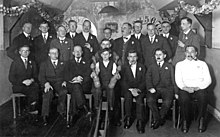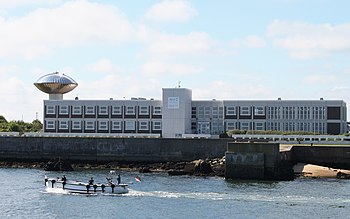Biological Institute Helgoland
The Biological Institution Helgoland (BAH) is a marine biological research and service facility on the North Sea island of Helgoland . In addition to the station on Sylt, it is one of the two research stations of the Alfred Wegener Institute (AWI) in Germany. The Center for Scientific Diving (AWI-CSD) is attached to the station.
history


Marine research on Heligoland is older than the station: in 1835, the natural scientist Christian Gottfried Ehrenberg on Heligoland demonstrated that the glow of the sea around the island is caused by the single cell Noctiluca scintillans . Johannes Müller recognized the potential of the island for his research and founded plankton research on Heligoland in 1845. Many descriptions of the local flora and fauna were created here and the term plankton itself was first introduced here. The biology of fish in the North Sea and bird migration were examined. The painter Heinrich Gätke became famous as an ornithologist.
After Heligoland came to the German Empire from British ownership, the Royal Prussian Biological Institute was founded on Heligoland in 1892. The first director was Friedrich Heincke , his successor from 1921 Wilhelm Mielck . The branch in List on the island of Sylt was established in 1924. In the Third Reich, the institute provided the local group leader and other leading employees of the NSDAP Helgoland. Arthur Hagmeier was director from 1934 to 1953, Helmuth Hertling from 1921 to 1939 assistant and custodian of the institution. After the bunker systems on Helgoland had been blown up , work could temporarily continue in the branch station on Sylt. As director, Adolf Bückmann rebuilt the work on the island in 1953 and created a so-called head station in Hamburg. In 1959 the BAH was reopened. In 1981 another institute building was set up as the new headquarters in Hamburg. The research ship Heincke also belonged to the institute .
After the BAH had been subordinate to the Federal Ministry of Education and Research for 20 years , it became part of the Alfred Wegener Institute (AWI) Foundation in 1998 .

job

The Biological Institute Helgoland maintains research laboratories, marine biological material supply facilities for research and teaching institutions (diving group, animal dispatch), course rooms with sea water supply that are unique in Germany for student and school excursions and academic training, as well as one of the longest plankton long-term studies in the world. In the Center for Scientific Diving annual training course for certification as tested is a research diver instead.
Marine biology students can also gain practical experience there as student research assistants, just like today's Leibniz Prize winner and Bremen professor Nicole Dubilier at the time.
Web links
- AWI Helgoland on the website of the Alfred Wegener Institute
Individual evidence
- ^ Cf. Robert J. Richards, The Tragic Sense of Life, Chicago and London 2008, page 118 and D. Zissler, Five scientists on excursion - a picture of marine biology on Helgoland before 1892, in: Helgoländer Meeresuntersuchungen (Helgoland Marine Research) Vol. 49, pp. 103-112, 1995
- ↑ Location - AWI. In: www.awi.de. Retrieved May 3, 2016 .
- ^ Eckhard Wallmann: A colony becomes German - Heligoland between the world wars. Bredstedt 2012.
- ↑ Petra Werner, The founding of the Royal Biological Institute on Helgoland and its history up to 1945. (= Helgoland marine investigations. Volume 47 Supplement). Hamburg 1993, pages 62 and 68
- ↑ Petra Werner, The founding of the Royal Biological Institute on Helgoland and its history up to 1945. (= Helgoland marine investigations. Volume 47 Supplement). Hamburg 1993, page 76f
- ↑ Erik Hagmeier, From the history of the Biological Institute Helgoland (BAH), (= Helgoland marine investigations. Volume 52 Supplement). Hamburg 1998, page 32
Coordinates: 54 ° 10 ′ 40.2 ″ N , 7 ° 53 ′ 29 ″ E




